GMC SIERRA 2003 Owner's Manual
Manufacturer: GMC, Model Year: 2003, Model line: SIERRA, Model: GMC SIERRA 2003Pages: 408, PDF Size: 2.58 MB
Page 301 of 408
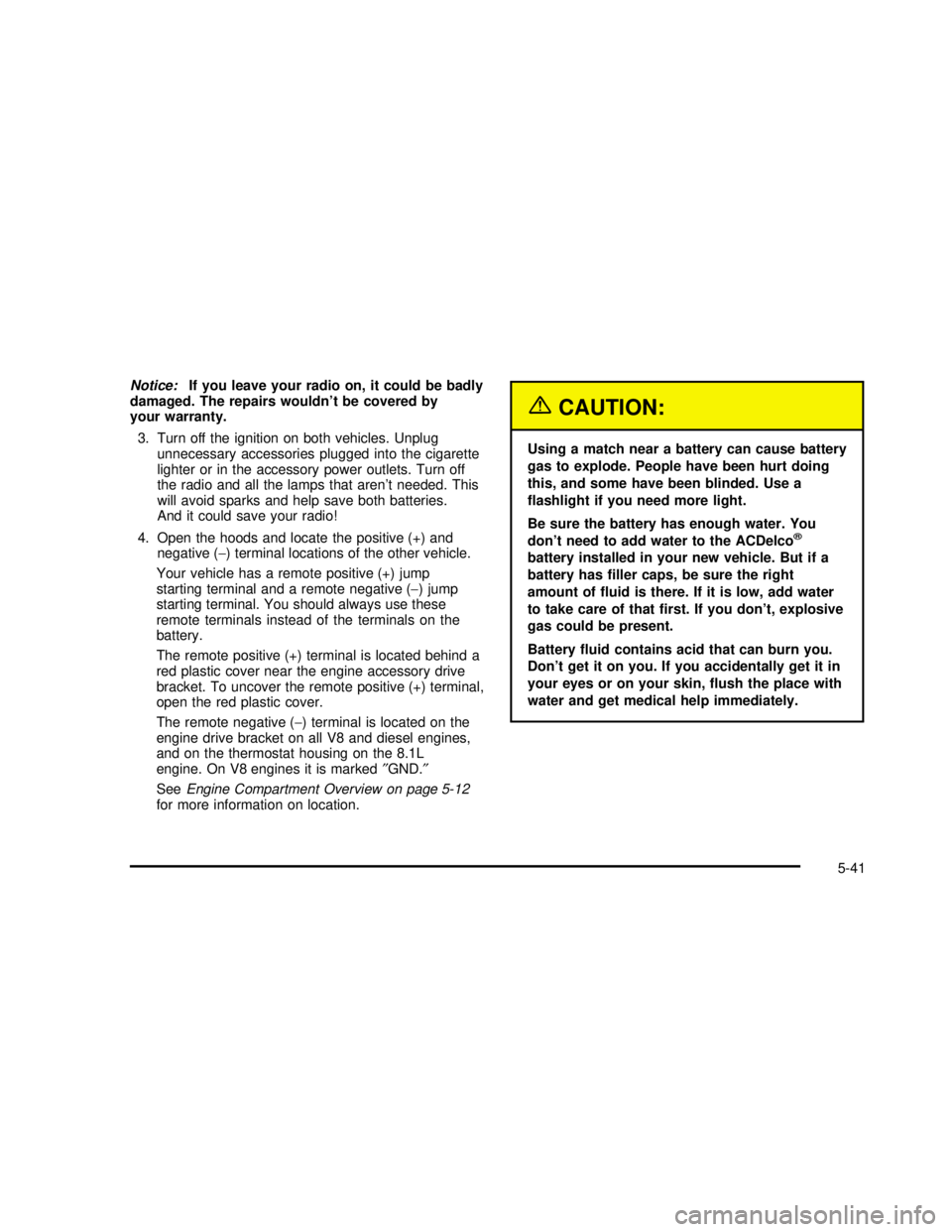
Notice:If you leave your radio on, it could be badly
damaged. The repairs wouldn’t be covered by
your warranty.
3. Turn off the ignition on both vehicles. Unplug
unnecessary accessories plugged into the cigarette
lighter or in the accessory power outlets. Turn off
the radio and all the lamps that aren’t needed. This
will avoid sparks and help save both batteries.
And it could save your radio!
4. Open the hoods and locate the positive (+) and
negative (−) terminal locations of the other vehicle.
Your vehicle has a remote positive (+) jump
starting terminal and a remote negative (−) jump
starting terminal. You should always use these
remote terminals instead of the terminals on the
battery.
The remote positive (+) terminal is located behind a
red plastic cover near the engine accessory drive
bracket. To uncover the remote positive (+) terminal,
open the red plastic cover.
The remote negative (−) terminal is located on the
engine drive bracket on all V8 and diesel engines,
and on the thermostat housing on the 8.1L
engine. On V8 engines it is marked″GND.″
SeeEngine Compartment Overview on page 5-12
for more information on location.
{CAUTION:
Using a match near a battery can cause battery
gas to explode. People have been hurt doing
this, and some have been blinded. Use a
flashlight if you need more light.
Be sure the battery has enough water. You
don’t need to add water to the ACDelco
®
battery installed in your new vehicle. But if a
battery hasfiller caps, be sure the right
amount offluid is there. If it is low, add water
to take care of thatfirst. If you don’t, explosive
gas could be present.
Batteryfluid contains acid that can burn you.
Don’t get it on you. If you accidentally get it in
your eyes or on your skin,flush the place with
water and get medical help immediately.
5-41
2003 - Sierra Denali
Page 302 of 408

{CAUTION:
Fans or other moving engine parts can injure
you badly. Keep your hands away from moving
parts once the engine is running.
5. Check that the jumper cables don’t have loose or
missing insulation. If they do, you could get a
shock. The vehicles could be damaged too.
Before you connect the cables, here are some
basic things you should know. Positive (+) will go to
positive (+) or a remote positive (+) terminal if the
vehicle has one. Negative (−) will go to a heavy,
unpainted metal engine part or a remote
negative (−) terminal if the vehicle has one.
Don’t connect positive (+) to negative (−)oryou’ll
get a short that would damage the battery and
maybe other parts too. And don’t connect the
negative (−) cable to the negative (−) terminal on
the dead battery because this can cause sparks.6. Connect the red
positive (+) cable to the
positive (+) terminal
of the vehicle with the
dead battery. Use
a remote positive (+)
terminal if the
vehicle has one.
7. Don’t let the other end
touch metal. Connect it
to the positive (+)
terminal of the good
battery. Use a remote
positive (+) terminal
if the vehicle has one.
5-42
2003 - Sierra Denali
Page 303 of 408

8. Now connect the black
negative (−) cable to the
good battery’s
negative (−) cable. Use a
remote negative (−)
terminal if the vehicle
has one.
Don’t let the other end touch anything until the next
step. The other end of the negative (−) cable
doesn’tgo to the dead battery. It goes to a heavy,
unpainted metal part, or to the remote negative (−)
terminal on the vehicle with the dead battery.9. Connect the other end
of the negative (−)
cable to the
negative (−) terminal of
the dead battery or
to a remote
negative (−) terminal
if the vehicle has one.
10. Now start the vehicle with the good battery and run
the engine for a while.
11. Try to start the vehicle that had the dead battery.
If it won’t start after a few tries, it probably needs
service.
Notice:Damage to your vehicle may result from
electrical shorting if jumper cables are removed
incorrectly. To prevent electrical shorting, take care
that the cables don’t touch each other or any
other metal. The repairs wouldn’t be covered by
your warranty.
5-43
2003 - Sierra Denali
Page 304 of 408

A. Heavy, Unpainted Metal Engine Part or Remote
Negative Terminal
B. Good Battery or Remote Positive (+) and Remote
Negative (−) Terminals
C. Dead Battery or Remote Positive (+) TerminalTo disconnect the jumper cables from both vehicles do
the following:
1. Disconnect the black negative (−) cable from the
vehicle that had the bad battery.
2. Disconnect the black negative (−) cable from
vehicle with the good battery.
3. Disconnect the red positive (+) cable from the
vehicle with the good battery.
4. Disconnect the red positive (+) cable from the other
vehicle.
5. Return the positive (+) remote terminal cover to its
original position.
Jumper Cable Removal
5-44
2003 - Sierra Denali
Page 305 of 408

All-Wheel Drive
Lubricant checks in this section also apply to these
vehicles. However, there are two additional systems that
need lubrication.
Transfer Case
When to Check Lubricant
Refer to the Maintenance Schedule to determine how
often to check the lubricant. SeePart C: Periodic
Maintenance Inspections on page 6-14.
How to Check Lubricant
To get an accurate reading, the vehicle should be on a
level surface.
If the level is below the bottom of thefiller plug hole,
you’ll need to add some lubricant. Add enough lubricant
to raise the level to the bottom of thefiller plug hole.
Use care not to overtighten the plug.
What to Use
Refer to the Maintenance Schedule to determine what
kind of lubricant to use. SeePart D: Recommended
Fluids and Lubricants on page 6-15.
(A) Fill Plug (B) Drain Plug
5-45
2003 - Sierra Denali
Page 306 of 408

Rear Axle
When to Check Lubricant
Refer to the Maintenance Schedule to determine how
often to check the lubricant. SeePart A: Scheduled
Maintenance Services on page 6-4.
How to Check Lubricant
To get an accurate reading, the vehicle should be on a
level surface.The proper level is from 5/8 inch to 1 5/8 inch (15 mm to
40 mm) below the bottom of thefiller plug hole. Add
only enoughfluid to reach the proper level. The proper
level for vehicles with QUADRASTEER™(4 Wheel
Steer) is from 0 to 1/4 inch (0 to 6 mm) below thefiller
plug hole. Add only enoughfluid to reach the proper
level.
What to Use
Refer to the Maintenance Schedule to determine what
kind of lubricant to use. SeePart D: Recommended
Fluids and Lubricants on page 6-15.
5-46
2003 - Sierra Denali
Page 307 of 408
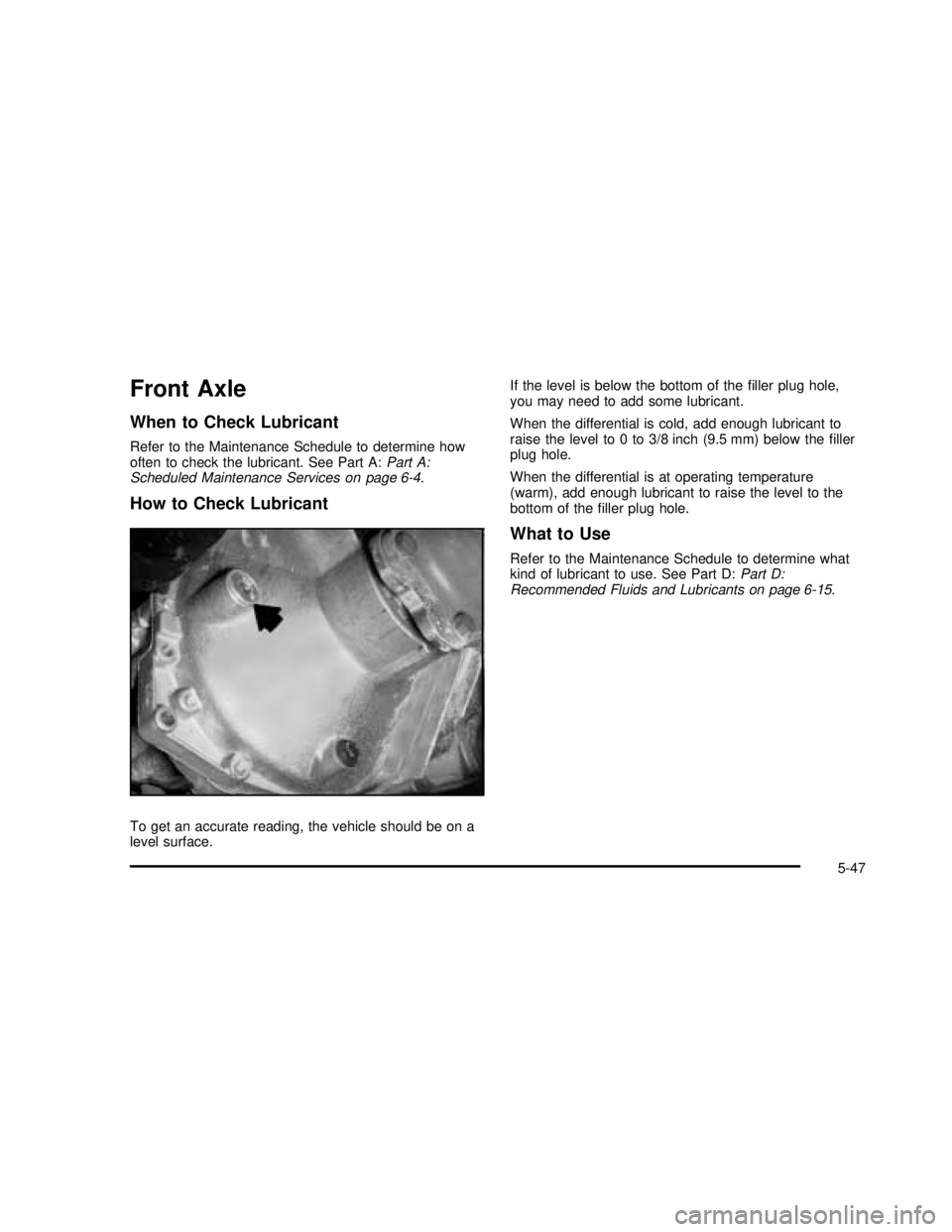
Front Axle
When to Check Lubricant
Refer to the Maintenance Schedule to determine how
often to check the lubricant. See Part A:Part A:
Scheduled Maintenance Services on page 6-4.
How to Check Lubricant
To get an accurate reading, the vehicle should be on a
level surface.If the level is below the bottom of thefiller plug hole,
you may need to add some lubricant.
When the differential is cold, add enough lubricant to
raise the level to 0 to 3/8 inch (9.5 mm) below thefiller
plug hole.
When the differential is at operating temperature
(warm), add enough lubricant to raise the level to the
bottom of thefiller plug hole.
What to Use
Refer to the Maintenance Schedule to determine what
kind of lubricant to use. See Part D:Part D:
Recommended Fluids and Lubricants on page 6-15.
5-47
2003 - Sierra Denali
Page 308 of 408
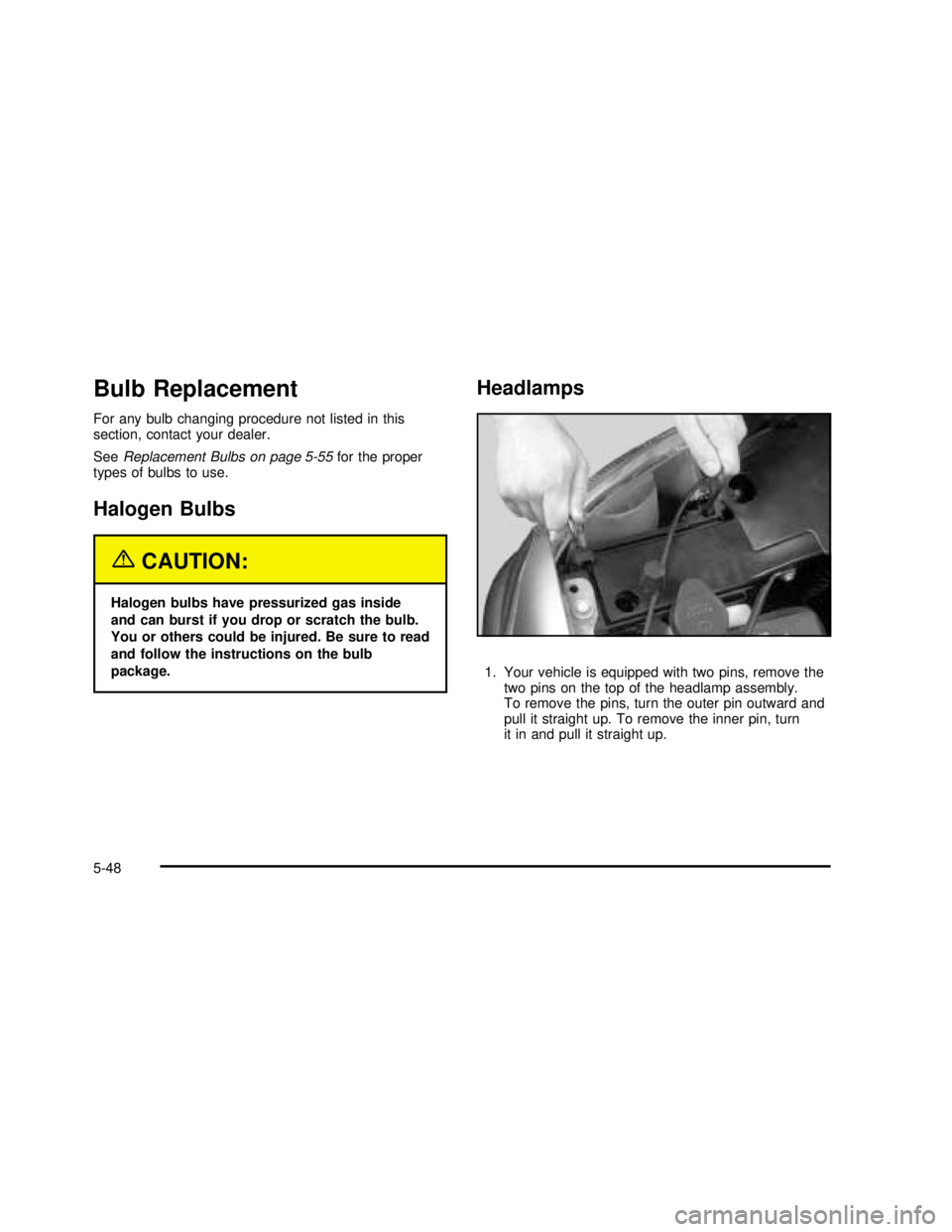
Bulb Replacement
For any bulb changing procedure not listed in this
section, contact your dealer.
SeeReplacement Bulbs on page 5-55for the proper
types of bulbs to use.
Halogen Bulbs
{CAUTION:
Halogen bulbs have pressurized gas inside
and can burst if you drop or scratch the bulb.
You or others could be injured. Be sure to read
and follow the instructions on the bulb
package.
Headlamps
1. Your vehicle is equipped with two pins, remove the
two pins on the top of the headlamp assembly.
To remove the pins, turn the outer pin outward and
pull it straight up. To remove the inner pin, turn
it in and pull it straight up.
5-48
2003 - Sierra Denali
Page 309 of 408
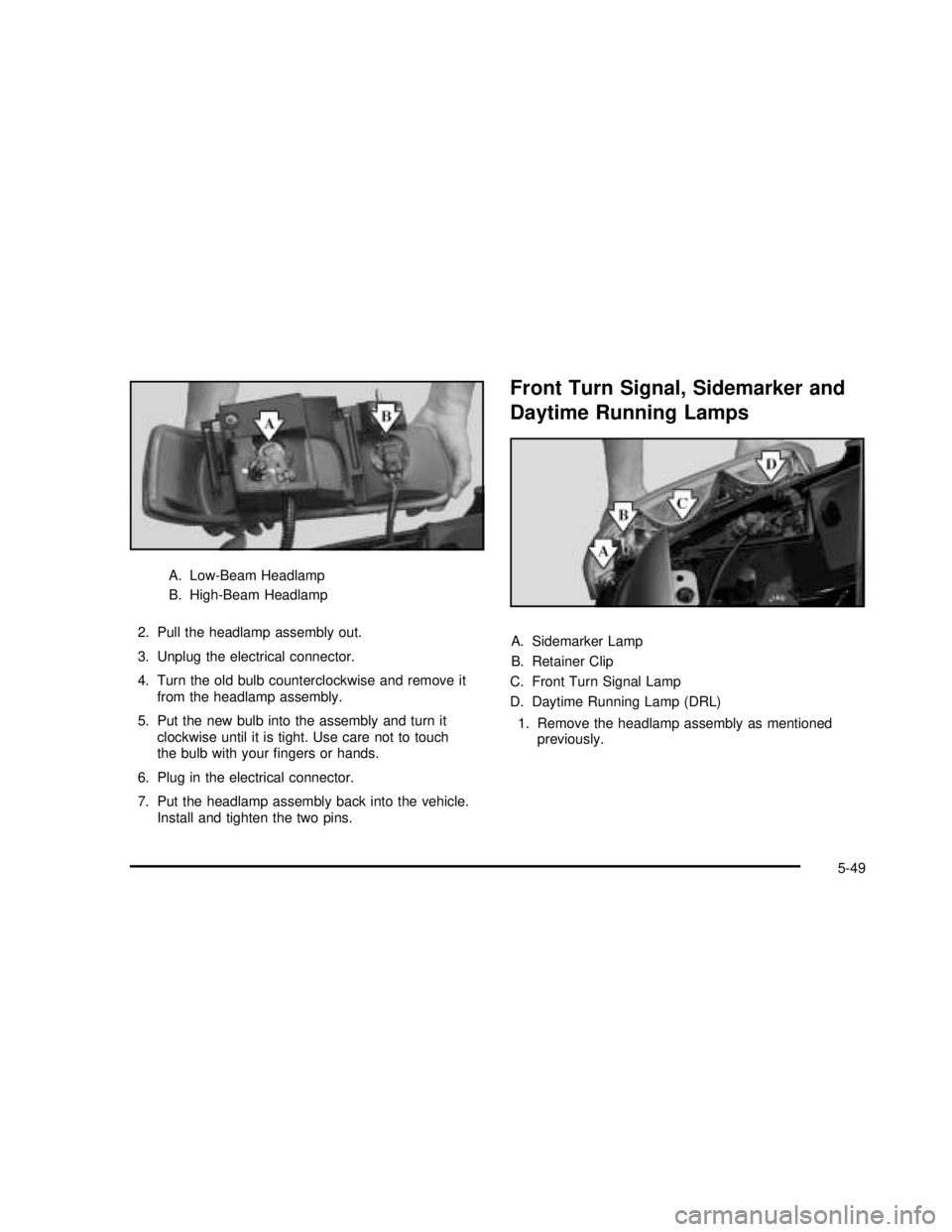
A. Low-Beam Headlamp
B. High-Beam Headlamp
2. Pull the headlamp assembly out.
3. Unplug the electrical connector.
4. Turn the old bulb counterclockwise and remove it
from the headlamp assembly.
5. Put the new bulb into the assembly and turn it
clockwise until it is tight. Use care not to touch
the bulb with yourfingers or hands.
6. Plug in the electrical connector.
7. Put the headlamp assembly back into the vehicle.
Install and tighten the two pins.
Front Turn Signal, Sidemarker and
Daytime Running Lamps
A. Sidemarker Lamp
B. Retainer Clip
C. Front Turn Signal Lamp
D. Daytime Running Lamp (DRL)
1. Remove the headlamp assembly as mentioned
previously.
5-49
2003 - Sierra Denali
Page 310 of 408
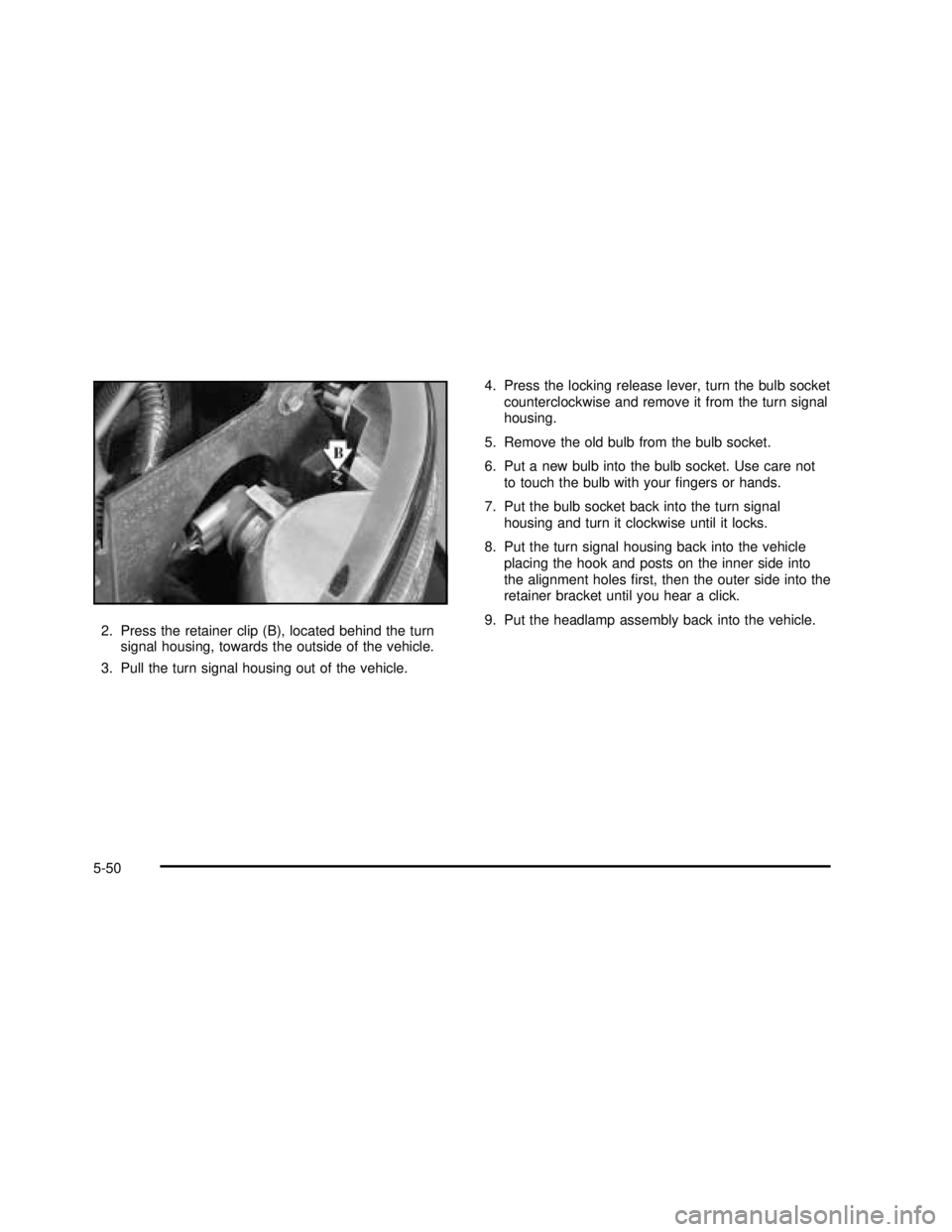
2. Press the retainer clip (B), located behind the turn
signal housing, towards the outside of the vehicle.
3. Pull the turn signal housing out of the vehicle.4. Press the locking release lever, turn the bulb socket
counterclockwise and remove it from the turn signal
housing.
5. Remove the old bulb from the bulb socket.
6. Put a new bulb into the bulb socket. Use care not
to touch the bulb with yourfingers or hands.
7. Put the bulb socket back into the turn signal
housing and turn it clockwise until it locks.
8. Put the turn signal housing back into the vehicle
placing the hook and posts on the inner side into
the alignment holesfirst, then the outer side into the
retainer bracket until you hear a click.
9. Put the headlamp assembly back into the vehicle.
5-50
2003 - Sierra Denali